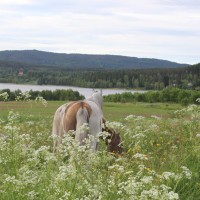Starch rich concentrates impair hindgut environment

The horse is a monogastric herbivore, a hindgut fermenter, and is depending on the fibrolytic microflora in caecum and colon to ferment fibre to short-chain fatty acids. Therefore it is important that the environment in caecum and colon, the hindgut, is right and this can be investigated by measuring the pH value. pH is a measure of acidity and the lower the pH the more acid is the environment.
When the microflora ferment fibre and produce short-chain fatty acids like acetic acid, propionic acid and butyric acid pH decreases moderately. Acids lower the pH value and the stronger the acid the lower the pH. When horses eat starch rich (cereal based) concentrates there is a risk that non digested starch reaches the hindgut causing the microflora to produce lactic acid which is a strong acid that can acidify the hindgut environment. Therefore there is a recommendation that horses should not eat more than 1.5 grams of starch per kg body weight (BW) and meal (maximum 5 g starch/kg BW and day)(Swedish feeding recommendations). However, very small starch intakes have shown to have an effect on the microflora and the hindgut environment.
In this study four coldblooded trotters were tested on four different feed rations: A) 14.5 kg timothy hay, B) 6 kg timothy hay and 3.8 kg pelleted barley, C) 6 kg timothy hay and 4.3 kg whole oats, D) 7.5 kg timothy hay, 2.2 kg pelleted sugar beet pulp (SBP) (soaked in 6 L water) and 0.4 kg sunflower oil. The morning meal consisted of: A) 4.5 kg hay equivalent to 0.3 g starch/kg BW, B) 2 kg hay and 2 kg barley equivalent to 2.2 g starch/kg BW, C) 2 kg hay and 2 kg oats equivalent to 1.7 g starch/kg BW, D) 2.5 kg hay, 0.8 kg SBP and 0.2 kg oil equivalent to 0.2 g starch/kg BW. After the morning meal pH was measured in caecum every minute for nine hours. Faecal samples were taken from rectum for pH measurements at 0, 150, 300 and 450 minutes after the morning meal.
The pH measurements in caecum after feeding showed different patterns for the different feed rations. When the horses were fed only forage (A) only small variations in pH between 6.8 and 6.9 were observed. For the starch rich feed rations with barley (B) and oats (C) the pH started to decrease 60-120 min after feeding and reached minimum values of 6.42 and 6.49, respectively, which is a potentially harmful environment for the fibrolytic microflora. On the barley diet the pH was also decreased for a longer period. When the horses were fed SBP and oil (D) the pH varied between 6.6 and 6.8 with no markedly decrease. The pH measurements in faeces showed no differences between the feed rations and also no differences between the different sampling times post feeding. The faecal pH did not reflect the changes in pH that were measured in the caecum and therefore faecal pH is not a good measurement to predict gut health.
In conclusion starch rich (cereal based) concentrates implied an impaired hindgut environment after feeding. Forage-only, SBP and oil did not show any markedly decrease in pH. Measurements of pH in faeces did not reflect the changes observed in the caecum.
Sara Muhonen, AgrD
